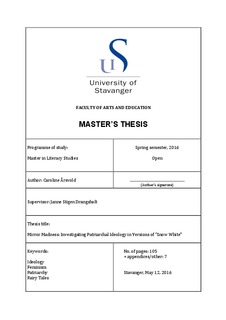Mirror Madness: Investigating Patriarchal Ideology in Versions of "Snow White"
Master thesis
Permanent lenke
http://hdl.handle.net/11250/2400304Utgivelsesdato
2016-05Metadata
Vis full innførselSamlinger
- Student papers (HF-IKS) [884]
Sammendrag
Fairy tales are an integral part of popular culture, as most people grow up listening to and reading these stories, while also watching adaptions of them in movies and TV series. This thesis seeks to analyze two versions of “Snow White” that are typically regarded as the traditional versions of the fairy tale, as these are well established in the landscape of popular fairy tales, that is “Snow White” (1857) by the brothers Grimm and the movie Snow White and the Seven Dwarfs (1937) by Walt Disney. These traditional tales will be juxtaposed with three postmodern fairy tales that are either variations of the traditional tale, or use “Snow White” as an intertext in order to scrutinize how these narratives disclose the ideology of the traditional tales, that is “The Snow Child” (1979) by Angela Carter, “Snow, Glass, Apples” (1999) by Neil Gaiman and Toni Morrison’s novel God Help the Child (2015).
This thesis will argue that fairy tales are capable of conveying central truths about culture, ideology and the structures in which we establish ourselves as individual subjects. This thesis aims to investigate the traces of patriarchal ideology that can be found in literature, and the roles that narratives play in challenging or affirming dominant ideology. The texts that have been selected for the analysis extend from 1857 to 2015, and it will be argued that the same ideological structures can be found in all these text, while also proposing that literature might function to displace this ideology.
This thesis is written to explore the relationships made possible between women within a patriarchal structure, and it will put a particularly focus on how images of female beauty restrict the roles available for women, and how these ideals of femininity inevitably turn women against each other. Throughout this thesis I will investigate how images of beauty and ideals of femininity concern both internal and external beauty, and how the concept of beauty then might work to instill social values in the readers, as the ideal of beauty in “Snow White” does not merely prescribe features of appearance, but also images of accepted female conduct.
Beskrivelse
Master's thesis in Literacy Studies

